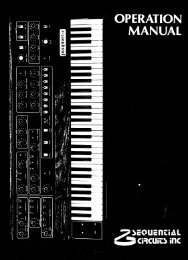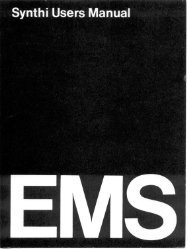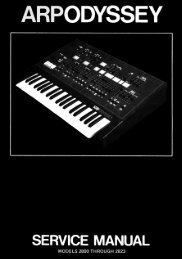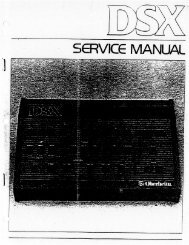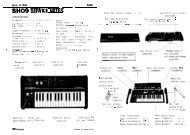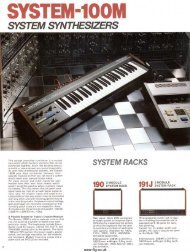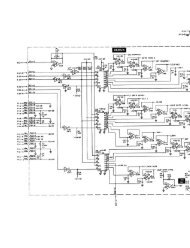ARP2600 - Fundamentals of Music Technology - Cyborgstudio.com
ARP2600 - Fundamentals of Music Technology - Cyborgstudio.com
ARP2600 - Fundamentals of Music Technology - Cyborgstudio.com
Create successful ePaper yourself
Turn your PDF publications into a flip-book with our unique Google optimized e-Paper software.
SECTION3VCO-2A FIRST LOOKIn Section 2, a basic voltage controlled oscillator (VCO-1) was discussed in detail. In this section,VCO-2 will be examined. Although VCO-2 is more <strong>com</strong>plex than VCO-1, all <strong>of</strong> the things that weresaid about VCO-1 apply to VCO-2. VCO-2 can be thought <strong>of</strong> as the ‘super oscillator’ on the ARP 2600since it is the most flexible, and thus the most powerful oscillator <strong>of</strong> the three found on the 2600. Thefirst thing one notices when looking at VCO-2 for the first time is the additional waveforms thatVCO-2 can produce. In addition to the saw wave, VCO-2 can produce sine, triangle, and pulse waves.SINE WAVESSine waves (see Figure 3-1) have a very pure sound, becausethey have only one harmonic, and that is the fundamental.CD track 07 It is also important to note that whilethe square and saw waves that VCO-1 produced ranged between0 Volts and +10 Volts, the sine wave VCO-2 producesranges between -5 Volts and +5 Volts. Overall, it still has thesame amplitude span as the waveforms VCO-1 produced,but because it dips into negative voltage, it is more flexible.When the sine wave output is used to modulate anothersource, it can actually send a negative value to that carrier,rather than just a positive value. This technique will be exploredin depth in a later section.+10V+5V0V-5V-10VtimeFigure 3-1: A sine waveTRIANGLE WAVESTriangle waves (see Figure 3-2) sound a little buzzy, butsmoother than a saw wave. Although they look very similar+10Vto a saw wave, they are actually most like square waves harmonically.CD track 07 Just like the square wave, they have+5Vonly the odd numbered harmonics. At first, this doesn’t seemtimeto make any sense. If the harmonic content <strong>of</strong> a waveform0Vdetermines its shape, and the triangle and square waves bothhave the same harmonics, shouldn’t they look alike and sound-5Valike? Actually, it is possible for two different waveforms to-10Vhave the same harmonics present, but present in differentamounts. In the triangle wave, some <strong>of</strong> the upper harmonicsare present in higher amounts than in the square wave. ThisFigure 3-2: A triangle wave gives it a buzzy sound which is different from the squarewave. It is also important to note that like the sine wave, the triangle wave ranges from -5 Volts to +5Volts, meaning that it can send a negative value to a carrier when it is being used as a modulator.018




